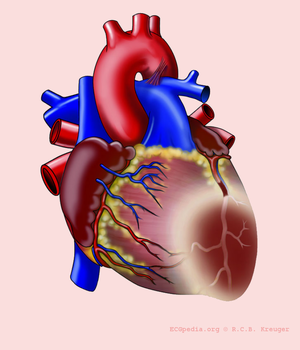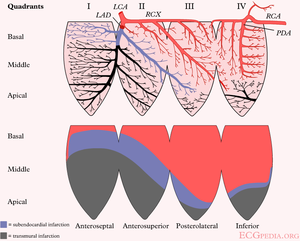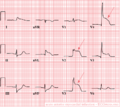Anterior MI: Difference between revisions
Jump to navigation
Jump to search
mNo edit summary |
mNo edit summary |
||
| Line 4: | Line 4: | ||
later: pathological Q-wave in the precordial leads V2 to V4-V5. | later: pathological Q-wave in the precordial leads V2 to V4-V5. | ||
[[Image:heart_with_AL_infarct.png|thumb|Anterolateral infarct caused by occlusion of the LAD.]] | [[Image:heart_with_AL_infarct.png|thumb|Anterolateral infarct caused by occlusion of the LAD.]] | ||
[[Image:stroomgebieden.png|thumb| The Left Anterior Descending (LAD) coronary artery is the most important coronary artery. On this mercatorprojection of the heart, the darkblue area is supplied by blood by the LAD.]] | |||
Anterior MI can involve the anterior part of the heart and a part of the ventricular septum. Is supplied by blood by the LAD. Can lead to [[Cardiac Aneurysm|a cardiac aneurysm]] if not treated timely. | |||
{{clr}} | {{clr}} | ||
==Examples== | ==Examples== | ||
Revision as of 09:54, 23 July 2007
| This is part of: Myocardial Infarction |
ECG-characteristics:[1]
ST-elevation in leads V1-V6, I and aVL. Maximum elevation in V3, maximal depression in III later: pathological Q-wave in the precordial leads V2 to V4-V5.
Anterior MI can involve the anterior part of the heart and a part of the ventricular septum. Is supplied by blood by the LAD. Can lead to a cardiac aneurysm if not treated timely.
Examples
A 2 weeks old anterior infarction with Q waves in V2-V4 and persisting ST elevation, a sign of formation of a cardiac aneurysm.






